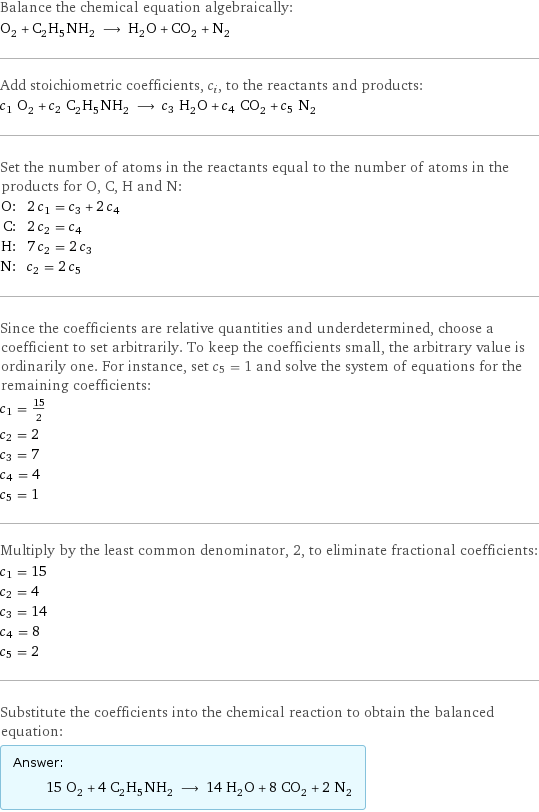Input interpretation

O_2 oxygen + C_2H_5NH_2 ethylamine ⟶ H_2O water + CO_2 carbon dioxide + N_2 nitrogen
Balanced equation

Balance the chemical equation algebraically: O_2 + C_2H_5NH_2 ⟶ H_2O + CO_2 + N_2 Add stoichiometric coefficients, c_i, to the reactants and products: c_1 O_2 + c_2 C_2H_5NH_2 ⟶ c_3 H_2O + c_4 CO_2 + c_5 N_2 Set the number of atoms in the reactants equal to the number of atoms in the products for O, C, H and N: O: | 2 c_1 = c_3 + 2 c_4 C: | 2 c_2 = c_4 H: | 7 c_2 = 2 c_3 N: | c_2 = 2 c_5 Since the coefficients are relative quantities and underdetermined, choose a coefficient to set arbitrarily. To keep the coefficients small, the arbitrary value is ordinarily one. For instance, set c_5 = 1 and solve the system of equations for the remaining coefficients: c_1 = 15/2 c_2 = 2 c_3 = 7 c_4 = 4 c_5 = 1 Multiply by the least common denominator, 2, to eliminate fractional coefficients: c_1 = 15 c_2 = 4 c_3 = 14 c_4 = 8 c_5 = 2 Substitute the coefficients into the chemical reaction to obtain the balanced equation: Answer: | | 15 O_2 + 4 C_2H_5NH_2 ⟶ 14 H_2O + 8 CO_2 + 2 N_2
Structures

+ ⟶ + +
Names

oxygen + ethylamine ⟶ water + carbon dioxide + nitrogen
Reaction thermodynamics
Enthalpy

ΔH_rxn^0 | -7150 kJ/mol - -190 kJ/mol = -6960 kJ/mol (exothermic)
Units

Equilibrium constant
![K_c = ([H2O]^14 [CO2]^8 [N2]^2)/([O2]^15 [C2H5NH2]^4)](../image_source/af4c9f3927e62743f812b63e852b04f9.png)
K_c = ([H2O]^14 [CO2]^8 [N2]^2)/([O2]^15 [C2H5NH2]^4)
Rate of reaction
![rate = -1/15 (Δ[O2])/(Δt) = -1/4 (Δ[C2H5NH2])/(Δt) = 1/14 (Δ[H2O])/(Δt) = 1/8 (Δ[CO2])/(Δt) = 1/2 (Δ[N2])/(Δt) (assuming constant volume and no accumulation of intermediates or side products)](../image_source/cfa99f9ea57d753aa13ec323be01b7cc.png)
rate = -1/15 (Δ[O2])/(Δt) = -1/4 (Δ[C2H5NH2])/(Δt) = 1/14 (Δ[H2O])/(Δt) = 1/8 (Δ[CO2])/(Δt) = 1/2 (Δ[N2])/(Δt) (assuming constant volume and no accumulation of intermediates or side products)
Chemical names and formulas

| oxygen | ethylamine | water | carbon dioxide | nitrogen formula | O_2 | C_2H_5NH_2 | H_2O | CO_2 | N_2 Hill formula | O_2 | C_2H_7N | H_2O | CO_2 | N_2 name | oxygen | ethylamine | water | carbon dioxide | nitrogen IUPAC name | molecular oxygen | ethanamine | water | carbon dioxide | molecular nitrogen